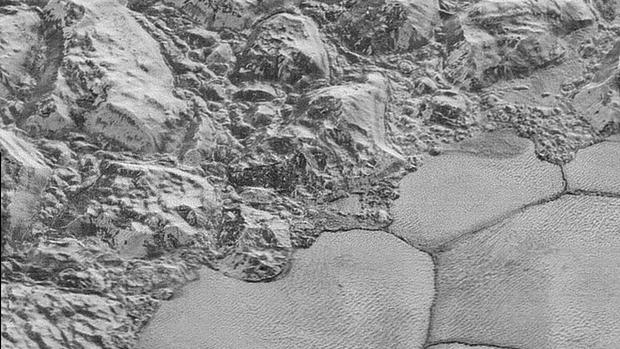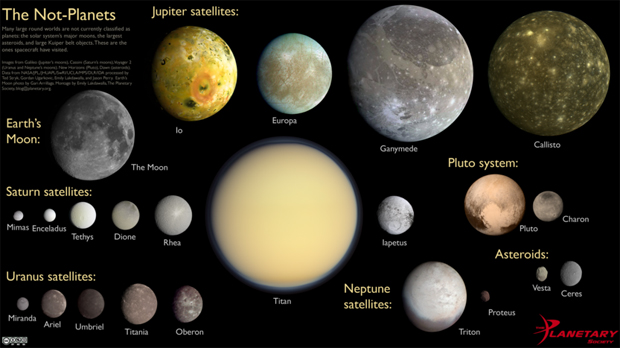Thrilled by Pluto mysteries, scientists await more data
Despite its enormous distance from the sun and ultra-low temperatures, Pluto appears to be a remarkably active world, with young, partially eroded craters, broad icy regions with very different compositions and a tenuous atmosphere that constantly escapes into space, scientists said Tuesday.
At least some of that lost atmosphere may find its way to Pluto's large moon Charon, condensing and sticking to the colder surface near a sunless pole as nitrogen and methane ice.
When a polar region rotates back into sunlight, ultraviolet radiation can convert the accumulated ices into complex molecules called tholins, deposits with a dark, reddish tint clearly visible to New Horizons. Charon, about half the size of Pluto, orbits at a distance of about 12,200 miles.
"This is an aesthetic moment as much as it is a science moment," said Jeff Moore, geology and geophysics team lead with the New Horizons project. "Having been a reader of science fiction and an admirer of space art, I don't believe that even the best space artists in the world ... could make a painting as beautiful as this. This is nature outdoing us."
He was referring to images of Pluto taken by the New Horizons probe before the spacecraft's flyby early Tuesday, including a dramatic false-color image in which the dwarf planet's natural salmon color was "stretched" with computer processing to bring out subtle compositional differences.
A broad heart-shaped region that appears the same general color in a full-frame photo released earlier Tuesday shows two distinct lobes in the false-color image. The left side appears yellowish with few discernible features while the right side shows up in light blue with a much more mottled appearance.
But researchers do not yet have an explanation for the differences. It's possible part of the structure was caused by an impact in the distant past, leaving a huge crater that later was filled or covered by nitrogen and methane ice due to some sort of transport process.
Spectroscopic data collected by New Horizons that was stored on board during the spacecraft's flyby Tuesday morning will be transmitted to Earth later, shedding light on the nature of the materials seen on the surface while stereo images expected later will show the relative heights of different regions.
"The heart actually is two different beasts," Moore said. "The west half of the heart, which is on the left-hand side, is smooth. We think it might actually really be smooth, although we can't be completely sure (due to image compression). Hopefully, the pictures we'll get back tomorrow will show whether there is, in fact, topography and texture in this region or not."
Several much smaller craters can be seen in the image, some of them relatively pristine, with sharply defined edges, while others appear to be filled in or eroded.
"We think at least some regions on Pluto are relatively ancient, they're probably several billion years old," Moore said. "Other places where we see no craters at all are very young, and perhaps are still currently undergoing geological evolution.
"We're also seeing evidence where craters seem to be destroyed. ... You see half the crater in one place but the other half of the crater is missing, which suggests some kind of erosion's operating on the surface."
He said scientists still don't understand the nature of sharply defined dark areas like a large region near the equator known as the whale. John Spencer, a co-investigator on the New Horizons team, said the material may be "cooked up" in Pluto's atmosphere by interactions with solar radiation and then deposited on the surface.
But he added that researchers don't yet understand why the material is "deposited on the equator preferentially."
As the resolution of the New Horizons images has improved, researchers have started informally naming various features based on public suggestions in keeping with Pluto's mythic underworld theme. The whale, for example, is known as Cthulhu after a creature in an H.P. Lovecraft story.
Pluto's north pole region does not yet show much topography, but that's probably because the sun is almost face on to the steeply tilted world, making it hard to discern shading, or shadows, that might otherwise indicate slopes.
Until stereo imagery is downlinked from New Horizons, viewers should be on guard against what Moore called "pathological shading," in which the mind can be tricked "so you might see a dark bright area and think oh, that's a hill, and it might be a depression."
His caution is widely shared by the New Horizons team, which has generally avoided speculation while awaiting more definitive data.
Asked to compare his expectations of Pluto to the reality New Horizons is revealing, Spencer said the biggest surprise is the overall complexity of the various surface terrains, textures and structures and the yet-to-be-determined processes responsible for them.
"In terms of the general distribution of bright and dark regions, we knew Pluto was very contrasty," he said, adding that the heart-shaped feature was visible as a diffuse bright area in low-resolution pictures captured earlier by the Hubble Space Telescope.
"It was just a big, bright blob, but we could tell it was there," he said. "So the overall distribution of the terrains and the contrast of them is something we had some advanced warning of. I don't think we had appreciated how well those dark terrains wrapped around the equator in a discrete band.
Beyond that, he added, "I think just the complexity of the albedo (brightness) patterns that we're seeing is surprising. And then this great color diversity (shows) that this is a really complicated surface with lots of different materials interacting in ways that we can't even imagine yet."
Still to come: analysis of Pluto's tenuous nitrogen atmosphere. William Grundy, an expert on planetary atmospheres, said researchers suspect that some of the nitrogen and methane in Pluto's atmosphere that leaks away into space eventually is deposited on Charon, which has a distinct, reddish north polar cap.
"We've been looking at this dark polar spot for a long time," he said. "And sure enough, it is quite red. And the reason I said 'sure enough' is because an idea has been bouncing around the science team for a couple of weeks now for a mechanism to do that. So it's gratifying to see that it is, in fact, red as we were predicting informally to ourselves."
Charon does not have a known atmosphere, although data collected aboard New Horizons during its flyby Tuesday could provide a definitive answer.
"The surface is too warm for (Pluto's escaping atmosphere) to stick, but if it hops around to the polar winter nightside, it can stick," he said. "That time period is decades. It gets very cold on that side."
Pluto's north pole currently is in direct sunlight. But nitrogen and methane deposited near the pole during the dark winter years could be converted into tholins by solar ultraviolet radiation after the north pole moves back into sunlight.
"So there's a reason for it to only happen on the poles, because that's the place where it gets really, really cold," Grundy said.
Interestingly, Pluto's atmosphere is escaping at a rate that will deplete it in about 10,000 years. Scientists believe it must be constantly replenished by volatiles -- materials like nitrogen and methane that have low boiling points and sublimate, or turn directly from a solid to a gas, when heated.
But just how that works to replenish Pluto's atmosphere is not yet known.
"Either there's a very deep layer of the volatiles, so every time you peel some off with an escaping atmosphere there's more there," said principal investigator Alan Stern. "Or the volatiles are being resupplied from the interior, possibly through volcanoes or geysers.
"I think New Horizons is going to shed a lot of light on that topic."



